
Thomas Andrews Jr. was a British businessman and shipbuilder. He was managing director and head of the drafting department of the shipbuilding company Harland and Wolff in Belfast, Ireland.

Lake freighters, or lakers, are bulk carrier vessels that operate on the Great Lakes of North America. These vessels are traditionally called boats, although classified as ships.
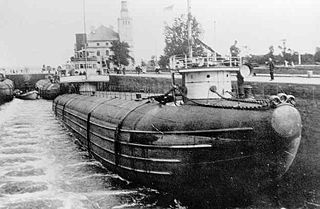
The Thomas Wilson was a whaleback freighter built in 1892 and used to haul bulk freight on the Great Lakes. The ship sank in Lake Superior just outside the harbor of Duluth, Minnesota, United States, on 7 June 1902, after a collision with the George Hadley. The wreck of the Thomas Wilson is one of the best remaining examples of a whaleback steamer, and it is also significant for the changes made in operating procedures at the Duluth harbor. The remains of the ship were listed on the National Register of Historic Places in 1992.

The Great Lakes Engineering Works (GLEW) was a leading shipbuilding company with a shipyard in Ecorse, Michigan, that operated between 1902 and 1960. Within three years of its formation, it was building fifty percent of the tonnage of all ships in the Great Lakes. During World War II, GLEW was commissioned by Pittsburgh Steamship Company and the U.S. Maritime Commission to build twenty-one ore freighters. Its innovations included the first self-unloader freighter, SS Wyandotte. GLEW is best known for its construction of the SS Edmund Fitzgerald.
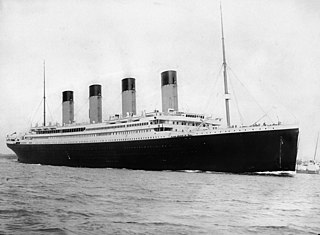
RMS Titanic was a British passenger liner, operated by the White Star Line, which sank in the North Atlantic Ocean on 15 April 1912 after striking an iceberg during her maiden voyage from Southampton, England, to New York City, United States. Of the estimated 2,224 passengers and crew aboard, more than 1,500 died, making it the deadliest sinking of a single ship up to that time. It remains the deadliest peacetime sinking of an ocean liner or cruise ship. The disaster drew public attention, provided foundational material for the disaster film genre, and has inspired many artistic works.
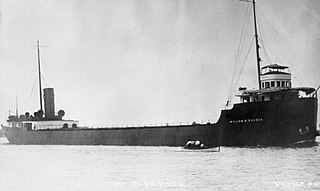
The SS William B. Davock was a lake freighter that was constructed in 1907 by Great Lakes Engineering Works, at their St. Clair, Michigan facility for the Vulcan Steamship Co.. She was operated by Vulcan Steamship from 1907 to 1915 in the Great Lakes coal, iron ore, grain and stone trades. In 1915 the ship came under the management of the Interlake Steamship Co.. While laid up for the winter (1922–23) in Fairport, Ohio, she was reconstructed and updated; this work changed her tonnage to 4220 gross and 2671 net. The Davock resumed its traditional trade pattern of coal carried to ports in the upper lakes from Lake Erie and iron ore carried from Lake Superior ports to the steel mills of Lake Erie and Lake Michigan.
The American Ship Building Company was the dominant shipbuilder on the Great Lakes before the Second World War. It started as Cleveland Shipbuilding in Cleveland, Ohio in 1888 and opened the yard in Lorain, Ohio in 1898. It changed its name to the American Ship Building Company in 1900, when it acquired Superior Shipbuilding, in Superior, Wisconsin; Toledo Shipbuilding, in Toledo, Ohio; and West Bay Shipbuilding, in West Bay City, Michigan. With the coming of World War I, the company also acquired Buffalo Dry Dock, in Buffalo, New York; Chicago Shipbuilding, in Chicago, Illinois; and Detroit Shipbuilding, in Wyandotte, Michigan. American Shipbuilding ranked 81st among United States corporations in the value of World War II military production contracts.
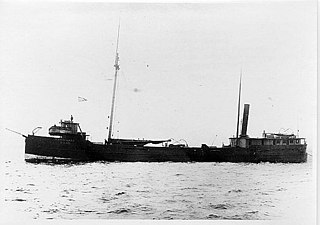
R. J. Hackett was a steamer built in 1869. When first launched, the ship's wide cross-section and long midships hold were unconventional, but the design's advantages in moving cargo through the inland lakes spawned many imitators. The Hackett is recognized as the first Great Lakes freighter, a vessel type that has dominated Great Lakes shipping for over 100 years. In 1905, the Hackett caught fire and sank on Whaleback Shoal in Green Bay, 9.5 miles (15.3 km) southeast of the Cedar River in Menominee County, Michigan. The wreck site was listed on the National Register of Historic Places in 1992.

The SS St. Marys Challenger is a freight-carrying vessel operating on the North American Great Lakes built in 1906. Originally an ore boat, she spent most of her career as a cement carrier when much larger ore boats became common. After a 107-year-long working career as a self-propelled boat, she was converted into a barge and paired with the tug Prentiss Brown as an articulated tug-barge. Before conversion, she was the oldest operating self-propelled lake freighter on the Great Lakes, as well as being one of the last freight-carrying vessels on the Great Lakes to be powered by steam engines.
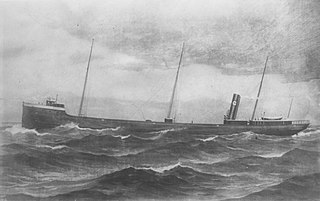
W.H. Gilcher was a steam lake freighter built in 1890–1891 by Cleveland Shipbuilding Company of Cleveland for Gilchrist, Gilcher & Schuck of Sandusky, with intention of transporting cargo between various ports located on Great Lakes. The ship was named after William H. Gilcher, one of the owners of the company. In October 1892 the freighter ran into a strong gale on Lake Michigan and foundered with the loss of eighteen men.
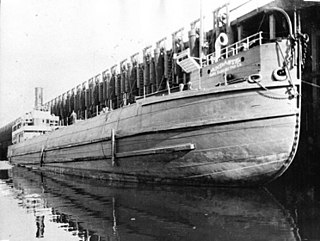
The SS Andaste was a Monitor-class vessel, built in 1892 by the Cleveland Ship Building Company for the Lake Superior Iron Company. The vessel is best known for sinking on Lake Michigan on the night of September 9–10, 1929, with all hands; 25 men were lost. As of 2020, the wreck of Andaste has not yet been located.
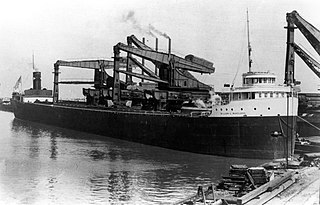
SS William C. Moreland was a 600-foot (180 m) long Great Lakes freighter that ran aground on Sawtooth Reef, Lake Superior on 18 October 1910, only a month after entering service. Visibility was poor due to the smoke from several forest fires, causing the William C. Moreland to ran full steam onto a reef. There were many attempts to salvage the ship, but eventually only the 278-foot (85 m) long stern was salvaged and was used to build the 580-foot (180 m) long Sir Trevor Dawson.
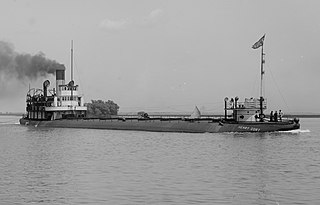
The Henry Cort was a 320-foot (98 m) long whaleback freighter. It sank four times during its career; finally running aground at Muskegon, Michigan in November, 1934. The ship broke apart over the winter and was scrapped in 1935.
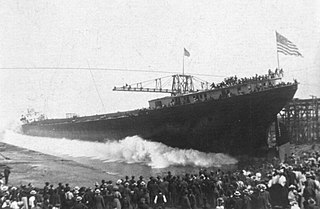
SS Edward Y. Townsend was a 603-foot (184 m) American Great Lakes freighter that served on the Great Lakes. She was primarily used to haul bulk cargoes such as iron ore, coal, grain and occasionally limestone. She was in service from her launching in 1906 to her sinking in 1968. She is best known for sinking on the way to the scrapper, near RMS Titanic, off the coast of Newfoundland.

SS Onoko was an iron hulled Great Lakes freighter. She was launched in 1882 in Cleveland, Ohio as hull number #4, and sank on September 14, 1915 in Lake Superior near Knife River, Minnesota. Onoko is thought to be the prototype for every single steel hulled Great Lakes Bulk carrier that ever sailed. These vessels made possible the cheap transport of bulk cargoes such as iron ore, coal and limestone. Her wreckage still remains on the bottom of Lake Superior and was listed on the National Register of Historic Places in 1992.

The Australasia was a wooden-hulled American Great Lakes freighter that served on the Great Lakes of North America between her construction in 1884 to her burning and sinking in 1896. On October 18, 1896, while loaded with coal, the Australasia sank in Lake Michigan near the town of Sevastopol, Door County, Wisconsin, United States, after burning off Cana Island. On July 3, 2013, the wreck of the Australasia was added to the National Register of Historic Places.
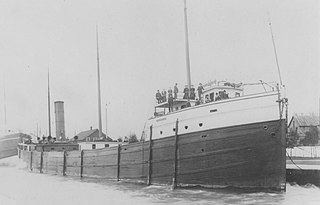
Iosco was a Great Lakes freighter that served on the Great Lakes from her construction in 1891 to her foundering on September 2, 1905, when she and her tow, the schooner barge Olive Jeanette sank on Lake Superior. While Olive Jeanette's wreck was located in over 300 feet (91 m) of water about eight miles (13 km) off the Huron Islands in the 1990s, Iosco's wreck has not yet been found.
Lake Frampton was a steam cargo ship built in 1918 by American Shipbuilding Company of Lorain for the United States Shipping Board (USSB) as part of the wartime shipbuilding program of the Emergency Fleet Corporation (EFC) to restore the nation's Merchant Marine. The vessel was employed in coastal trade during her career and collided with another steamer, SS Comus, and sank in July 1920 on one of her regular trips with a loss of two men.
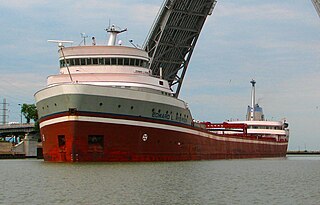
SS Edward L. Ryerson is a steel-hulled American Great Lakes freighter that entered service in 1960. Built between April 1959 and January 1960 for the Inland Steel Company, she was the third of the thirteen so-called 730-class of lake freighters, each of which shared the unofficial title of "Queen of the Lakes" because of their record-breaking length. She was not only the last steam-powered freighter built on the lakes but also the last one that was not a self-unloader. Since 2009, she has been in long-term layup in Superior, Wisconsin. She is one of only two American-owned straight deck lake freighters, the other being John Sherwin, built in 1958.
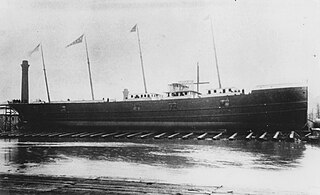
SS Cayuga was a steel-hulled American package freighter in service between 1889 and 1895. She was built in 1889 in Cleveland, Ohio, by the Globe Iron Works Company for the Lehigh Valley Transit Company of Buffalo, New York. One of five identical sister ships, Cayuga entered service in 1889, carrying package freight between Buffalo and Chicago, Illinois, also making stops in Milwaukee, Wisconsin, and Gladstone, Michigan. Prior to her sinking, Cayuga was involved in two accidents. In the first in 1890, when she went aground in a gale just outside of Buffalo harbour; six tugboats managed to pull her free that same day. The second accident occurred in 1891, when Cayuga was involved in a collision with the package freighter Delaware near Cheboygan, Michigan.



















